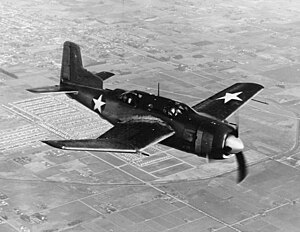Douglas BTD Destroyer
| BTD Destroyer | |
|---|---|
 |
|
| The XSB2D-1 in 1943 | |
| Role | Torpedo/dive bomber |
| Manufacturer | Douglas Aircraft Corporation |
| First flight | 8 April 1943 |
| Introduction | 1944 |
| Retired | 1945 |
| Primary user | United States Navy |
| Number built | 30 |
The Douglas BTD Destroyer was an American dive/ torpedo bomber developed for the United States Navy during World War II.
On 20 June 1941, the United States Navy placed an order with the Douglas Aircraft Company for two prototypes of a new two-seat dive bomber to replace both the Douglas SBD Dauntless and the new Curtiss SB2C Helldiver, designated XSB2D-1. The resulting aircraft, designed by a team led by Ed Heinemann, was a large single-engined mid-winged monoplane. It had a laminar flow gull-wing, and unusually for a carrier-based aircraft of the time, a tricycle undercarriage. It was fitted with a bomb bay and underwing racks for up to 4,200 lb (1,900 kg), while defensive armament consisted of two wing-mounted 20 mm (0.79 in) cannon and two remote-controlled turrets, each with two .50 in (12.7 mm) machine guns.
The prototype first flew on 8 April 1943, demonstrating excellent performance, being much faster and carrying nearly double the bombload of the Helldiver, and orders for 358 SB2D-1s quickly followed. The U.S. Navy changed its requirements, however, wanting single-seat carrier-based torpedo/dive bombers without defensive turrets, and Douglas reworked the SB2D by removing the turrets and second crewman, while adding more fuel and armor, producing the BTD-1 Destroyer. The orders for SB2Ds were converted to BTD-1s, with the first BTD flying on 5 March 1944.
The first production BTD-1s were completed in June 1944. By the time Japan surrendered in August 1945, only 28 aircraft had been delivered, and production was cancelled, along with other aircraft types that had been designed from the start as single-seaters, such as the Martin AM Mauler. None saw combat action. In any event, Heinemann and his team were already working on developing the single-seat BT2D that became the Douglas A-1 Skyraider.
BTD-1 Destroyer, Bureau Number 4959, is under restoration for display at the Wings of Eagles Discovery Center, Elmira-Corning Regional Airport, Elmira, New York. This aircraft had long been in the Florence Air & Missile Museum collection until the museum's closing in 1997. In September 2015 the aircraft was relocated to the Hixson Flight Museum in Rome, Georgia.
...
Wikipedia
